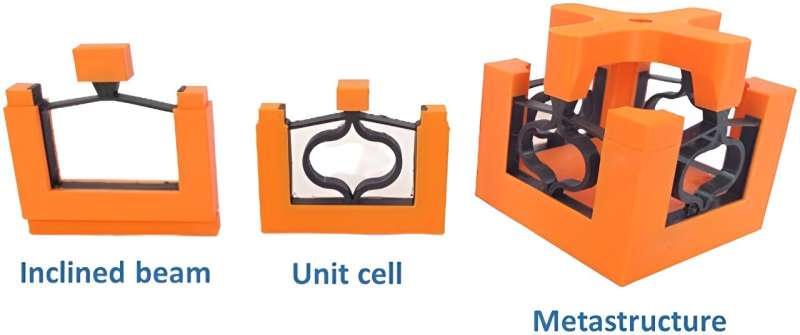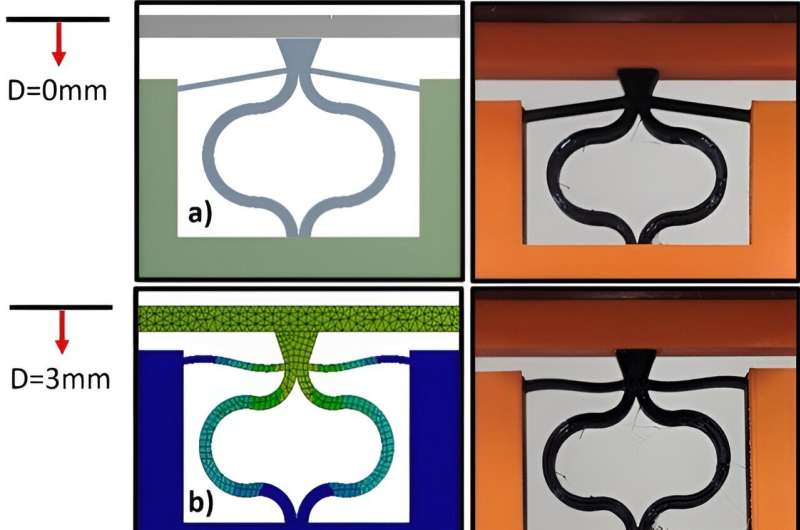
September 2, 2024 by University of Sharjah
Collected at: https://techxplore.com/news/2024-09-scientists-vibration-machines-instruments.html
Scientists say they have developed a structure that can absorb and reduce vibrations of engineering and mechanical gadgets more effectively than conventional systems hitherto used to contain the trembling of machines and devices across various industries.
The finding, reported in the journal Scientific Reports, is related to a uniquely designed structure that combines two types of materials, according to University of Sharjah’s Professor of civil and environmental engineering, Moussa Leblouba, who is a co-author.
“The structure we designed is unique because it combines two types of materials: one that easily bends (negative stiffness) and one that resists bending (positive stiffness),” said Prof. Leblouba. “When these materials work together, they create a special behavior where the structure can support heavy loads while remaining almost unaffected by small vibrations.”
The study is a collaborative effort bringing together scientists from the University of Sharjah’s College of Engineering, India’s National Institute of Technology, and Saudi Arabia’s King Fahd University.
The scientists write, “From the analytical, numerical, and experimental studies, it was shown that the proposed model not only represents QZS characteristics but also delivers effective vibration isolation performance, particularly within low-frequency ranges.
“This demonstrates the metastructure’s capability to mitigate vibrational impacts through innovative design and strategic material utilization, hence, establishing its potential applicability in practical engineering solutions where vibration isolation is critical.”
The novel “metastructure” exhibits quasi-zero-stiffness (QZS) properties. It is based on the High Static and Low Dynamic Stiffness mechanism. It consists of four-unit cells arranged in parallel, each incorporating inclined beams and semicircular arches.
Quasi-Zero-Stiffness or QZS is a condition where the structure shows extremely low resistance to movement within a certain range, allowing it to effectively isolate vibrations while still supporting a load. This unique characteristic is key to the ability of the “metastructure” to maintain stability in sensitive environments.
Prof. Leblouba said the study aimed to create “a solution that is not only theoretically sound but also practical for real-world applications in industries that require precise control over vibrations.
“In our research, we developed and validated a new type of structure that helps in controlling vibrations, which are unwanted movements that can affect the performance of machines and devices.”

The study’s lead author, Dr. Srajan Dalela, a project scientist at the Department of Mechanical Engineering, National Institute of Technology Rourkela in India, said the innovation stands out in its ability to suppress vibrations of all types of machinery in different industries.
“This structure’s ability to maintain stability while reducing vibrations opens up new possibilities for protecting sensitive equipment across various industries,” said Dr. Dalela.
“Our research introduces a new frontier in vibration control, offering a practical solution to a problem that has challenged engineers for decades.”
The scientists validated the effectiveness of their newly developed “metastructure” through multiple analyses and experiments, added Prof. Leblouba.
“We tested this structure through computer simulations and real-life experiments, and our results confirmed that it can effectively reduce vibrations, especially at low frequencies where traditional methods struggle.
“This means that our structure could be used in various fields, like aerospace, medical imaging, and precision instruments, to protect sensitive equipment from vibrations and improve their performance.”
Engineers and mechanics have for long strived to find a solution to stop machines and devices from vibrating when in operation. Machine vibration has always been a significant challenge for them.
The scientists describe their invention as a lightweight structure that “can isolate vibration for varying frequency ranges starting from lower frequency range to higher [ranges]”, endowing it with a wide range of applications in various industries.
In their paper they highlight the industrial spheres where their novel structure “helps in absorbing and dissipating the vibration” of different machines and devices.
They maintain that their compact and lightweight structure offers exciting possibilities of potential applications. Their study points out that their invention has the ability “to mitigate vibrations from reaching telescopes, and positioning of telescopic mounts” when applied in optical systems.

Regarding medical imaging devices, they write their novel structure “can provide a stable environment for MRI machines to produce high-quality images, and in high-precision microscopes to ensure stable imaging.”
The structure, according to the study, is likewise of practical implications for semiconductor manufacturing systems as it can “isolate sensitive equipment and maintain the necessary stability.”
In the sphere of precision instruments and laboratories, the authors show their structure to have the capacity to “maintain the stability required for accurate results.”
The authors also cite industrial machinery as a useful area where control of vibration is important for “stable environment and accuracy.”
“This innovation can improve the performance and lifespan of precision instruments, medical devices, aerospace equipment, and more, making these technologies more reliable and efficient,” said Prof. Leblouba, adding that the design “can be adjusted depending on the load it needs to support, making it versatile for different applications.”
Asked about the importance of the invention, Prof. Leblouba said, “The impact of our project is substantial, as it offers a new solution to a longstanding problem in many industries … This innovation can improve the performance and lifespan of precision instruments, medical devices, aerospace equipment, and more, making these technologies more reliable and efficient.”
Prof. Leblouba said the invention stands out as the first of its kind to work well in situations where other structures have failed, particularly in low-frequency vibrations.
“The structure’s design can be adjusted depending on the load it needs to support, making it versatile for different applications. Our experiments showed that this structure can maintain its vibration control abilities even when subjected to varying conditions.”
The scientists are taking a wait-and-see attitude to find out how the industry is going to react to their invention. But they are upbeat and hopeful their findings will eventually make a difference.
Associate Professor Abul Kalam from King Khalid University’s College of Science in Saudi Arabia said, “We’re excited to see how our findings can be applied in real-world settings, where precision and reliability are paramount.”
More information: Srajan Dalela et al, Nonlinear static and dynamic response of a metastructure exhibiting quasi-zero-stiffness characteristics for vibration control: an experimental validation, Scientific Reports (2024). DOI: 10.1038/s41598-024-70126-x
Journal information: Scientific Reports

Leave a Reply